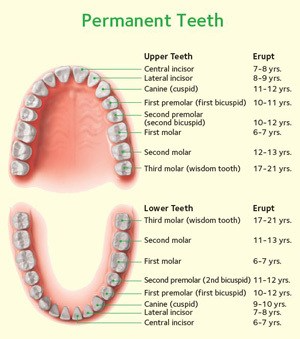Eruption Sequence Of Primary And Permanent Teeth
Posted July 4, 2022 by Anusha ‐ 3 min read
Tooth eruption can be defined as the movement of the tooth germ from its non-functional position in the alveolar processes to its final functional position in the oral cavity. The term eruption is different from the term emergence as the latter refers to the moment of appearance of any aspect of the cusp or crown through the gingival tissue.
Eruption Of Primary Teeth
The primary tooth eruption begins around the age of six months and can last until the age of three years. During this stage, the child’s gums or gingival tissue may be sore and irritable. You can soothe them by gently rubbing the gums with a cold, wet cloth, the back of a cold spoon, and with a clean finger.

The timing and sequence for the eruption of a child’s 20 primary teeth is shown below
- A child’s central teeth, both upper and lower, are the first to appear and then other teeth erupt sequentially moving toward the back of the arch.
- The exception to this is the first molars, which typically erupt before the cuspids also known as canines.
- The first teeth to erupt are the lower and upper central incisors, which erupt between the ages of 6 12 months.
- The next to erupt are the lateral incisors between 9-16 months, followed by the first molars from 13-19 months.
- Next, the cuspids erupt from 16-23 months. Lastly, between 23 and 33 months, the second molars erupt.
Baby Tooth Shedding
Children typically begin shedding their primary teeth at the age of 6 years, starting with the central incisors and followed about a year later by the lateral incisors. The first molars are shed next, closely followed by the lower canines. The upper canines and both upper and lower second molars are shed last.
Facts of primary tooth eruption
- The very common and general rule of thumb is that for every 6 months of life, approximately 4 teeth will erupt.
- Girls generally precede boys in tooth eruption process.
- The lower teeth usually erupt before the upper teeth.
- Teeth in both jaws (upper and lower) usually erupt in pairs one on the right and one on the left side.
- Primary teeth are smaller and milkish white in color than the permanent teeth that will follow.
- By the time a child is 2 to 3 years of age, all primary teeth should have erupted.
- Shortly after the age of 4, the jaw and facial bones of the child begin to grow, creating spaces between the primary teeth. This is a perfectly natural growth process that provides the necessary space for the larger permanent teeth to emerge. Between the ages of 6 and 12, a mixture of both primary teeth and permanent teeth reside in the oral cavity.
Eruption Of Permanent Teeth

- The average child has their full set of 20 primary teeth by the age of 3 years. Between the ages of about 6 and 7 years, the primary teeth start to shed, and the permanent teeth begin to come through.
- By the age of about 21 years, the average person has 32 permanent teeth 16 in the upper jaw and 16 in the lower jaw. In some children, the first permanent molars are the first to emerge and in others, the incisors are the first to emerge.
- By the age of 13, most of the 28 permanent teeth will be in place.
- One to four wisdom teeth, or third molars, emerge between the ages of 17 and 21, bringing the total number of permanent teeth up to 32.